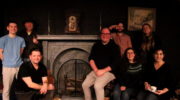
reduces the need for fertilizer, captures carbon, and helps soil hold water. Seed piece: 800x (SM&NC/contributed photo)
Stamford, CT – The Stamford Museum & Nature Center is pleased to present “Robert Dash: Food for Thought – Micro Views of Sustenance: Threats and Prospects,” a powerful exhibition featuring 36 large-scale color photographs related to the subject of climate change.
The exhibition opens to the public on February 18, 2022, and will be on view through June 5, 2022. Gallery hours are Monday through Saturday, 9AM to 4:30PM, and 11AM to 4:30PM on Sundays. An Evening Reception and Artist Talk, coinciding with Earth Week, will take place on Thursday, April 21 from 5-7PM. Pre-registration for the event is requested at www.stamfordmuseum.org/dash.
“We’re honored to present Robert Dash’s beautiful work in Connecticut for the first time,” said Melissa H. Mulrooney, CEO of the Stamford Museum & Nature Center. “His photographs capture the zeitgeist of today’s conversation around climate change, and we think our visitors will appreciate the message of these images and the power they convey.”

Artist and photographer, Robert Dash, uses photomontage to create a surreal dialogue between everyday foods and microscopic parts of themselves. The exhibition offers a perspective on how one part of nature – our food – is intrinsically connected to climate change. Fossil fuel combustion is the source of most of the blame related to climate change, yet our collective exploitation of nature has caused tremendous ecosystem damage as well. The beauty of the artist’s images belies the urgent consequences of the climate crisis. Each image requires the visitor to examine, ponder, and face the ecological breakdown of our current agricultural systems.
Fascinated by the textures, patterns, and shapes of foods related to climate change, Dash combines SEM (scanning electron microscope) micrographs of pollens, seeds, leaves, and insects with macro photographic images. Using hundreds of individual images to produce one final study, Dash’s photographs are intricate studies in form and meaning. A horde of buckwheat groats crowd on the edge of a precipice, dropping one-by-one into a black void in Buckwheat Cliffs (2019). A moth fractures into smaller, colorful segments in Requiem for Pollinators (2020). His hybridized photographs create a new visual language rooted in metaphor, fact, humor, story, surrealism, and environmental commentary. The artist’s hope is that his intricate images will provoke ideas and questions related to climate change, while connecting people to the world they have helped shape and continuing a dialogue about how we can affect, and hopefully improve, the world we live in.
“Robert’s photographs are remarkably timely,” said Maeve Lawler, Curator of Collections & Exhibitions at the Stamford Museum & Nature Center. “His visually striking images will spark important conversations surrounding climate change, reinforcing art’s ability to act as a universal conduit for communication.”
Robert Dash is an educator, naturalist, and photographer. Dash’s photographs have been published by National Geographic, TIME, Buzzfeed, and Lenswork. His work has appeared in galleries and juried shows in the US and internationally. He was shortlisted for the Visura/UPA Grant for Storytelling on Climate Change, 2018. In 2016 he presented the TEDx lecture, “The Intercourse of Nature.” Most recently, his work was the subject of the article “The Hidden Beauty of the Plants that Feed the World,” published in National Geographic in September 2021.
Getting there
Stamford Museum & Nature Center’s Bendel Mansion & Galleries are located at 39 Scofieldtown Road, Stamford, CT (3/4 mile North of Merritt Parkway Exit 35.) For more information call 203.977.6521 or visit www.stamfordmuseum.org.




